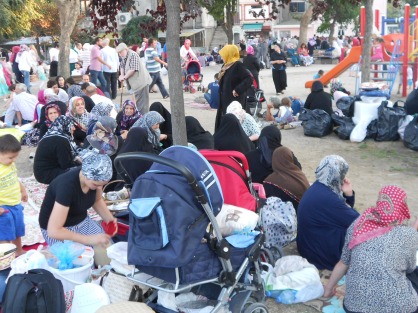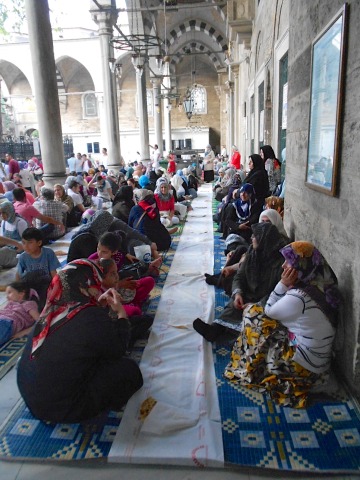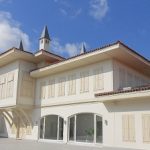Really, there is nothing quite like it. Think back to the excitement of those Christmas mornings of childhood, magnify that feeling by a hundred and still you wouldn’t quite be able to evoke the tension of the last 15 minutes before the break of the fast (iftar) during Ramazan in İstanbul. The atmosphere fizzes and pops with anticipation as families settle down with their picnic baskets in Sultanahmet. The air is electric with expectancy. Then the ezan sounds and, as one, hands rise to mouths dispensing merciful glasses of water, dates, olives and cigarettes.
After a week of watching happy picnickers occupying the lawns of Sultanahmet as in some bizarre Islamic take on Glastonbury without the mud (or music, come to that), I finally decided to pop over to Eyüp and see what iftar was like in the city’s most sacred suburb, the burial place of the friend and standard-bearer of the Prophet Mohammed.
I board one of the Golden Horn ferries and disembark at Eyüp. The plan had been to approach the mosque as the sultans would have done along the Çülus Yolu (Accession Way), a plan that immediately collapses since the path past some of the most important monuments has been closed off to make way for an officially organised iftar event.
No matter. A short diversion and soon I’m ambling along another tomb-and-gravestone-lined path where I’m astounded to find picnickers already spreading out their sofras (tablecloths). It’s the same story in the courtyard of the great Eyüp Cami itself. Early comers have even managed to bag places for themselves against the wall of the portico in front of the mosque and sit with their roundels of pide bread laid out in front of them waiting for the signal that will permit them to eat.
The crowd is thick, the atmosphere astonishingly good-humoured given that most people have been deprived of food, drink or nicotine for a long seventeen hours of summer heat. It probably helps that children are exempted from the fast, which means that there’s none of the grizzling that so often accompanies crowded family gatherings.
Outside the main gate to the mosque I find local restaurateurs hotly vying with one another to scoop the paying iftar customers. In a bakery that claims to have been in business since 1883 the shelves are all but bare. In all this heady, focused commercialism I find myself blissfully invisible, a great relief after day-time Sultanahmet.
Slowly I make my way through the crowd, passing stalls selling dates, dates and yet more dates (the treat with which Mohammed himself is believed to have broken his fast), and head for the Feshane, the long plummy-pink-painted waterfront building where thousands upon thousands of fezzes were manufactured in the latter days of the Ottoman Empire.
Here a half-hearted and disappointing fair has been set up inside the building offering a confusing mix of fridges for sale, advertisements for the police force featuring an infuriatingly tear-gas-free picture of İstiklal Caddesi, and giant photo frames through which to pop one’s head for a special Ramazan photograph of self as Ottoman princess or self as outsize Karagöz puppet. Outside in the garden it’s more of the same with giant balloons advertising phone companies, hoardings touting luxury cars and pushcarts offering everything from boiled sweetcorn to candy-floss.
I wander down to the waterfront just as one of the replica sultans’ caiques comes drifting into its moorings, its luscious gold and red standing out against the inky backdrop of the water. Here at a gathering of cheapie, pop-up restaurants staff rush to put the finishing touches to hundreds of döner sandwiches and gözleme pancakes as the witching hour draws near.
I sit myself down in the midst of it all. I wonder at how such a huge crowd of people can manage to get together so peacefully. Most of all I wonder at the logistics of getting food to them all at precisely the right moment.
Then the voice of the muezzin rises over Eyüp and I find myself the only person not eating.
 Written: 30 July 2013
Written: 30 July 2013

